Technical Update
New RSR BMW Motorcycle Clutches
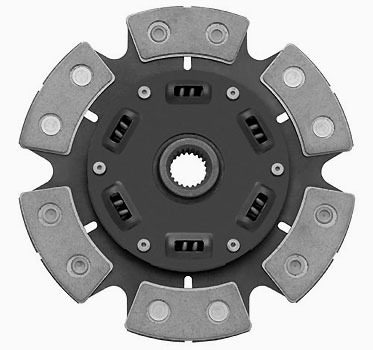
RB Racing has developed a new line of BMW motorcycle clutches for both normally aspirated and turbocharged applications. Stock BMW motorcycle clutch weaknesses, i.e. damaged transmission splines, inadequate or improper lubrication, and slippage have been addressed for both 165mm and 180mm clutch styles. Specific designs are offered for street, turbocharged and full race applications.
New Bosch Billet Fuel Regulators
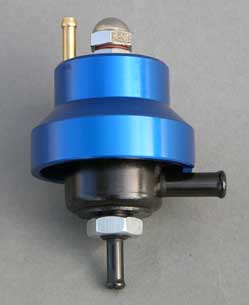
We have improved our fuel regulators by using a Bosch Billet Adjustable Regulator. We use these in all our fuel system upgrades as well as with our turbocharger systems. More precise and better seats with a hardened and ground ball and socket design. Holds pressure better for smoother operation and more reliable low battery condition starting.
Part Number 06-1023 $195.00. Comes with 12mm x 1.5 jam nut for mounting.
Water Injection for K1200 Turbos
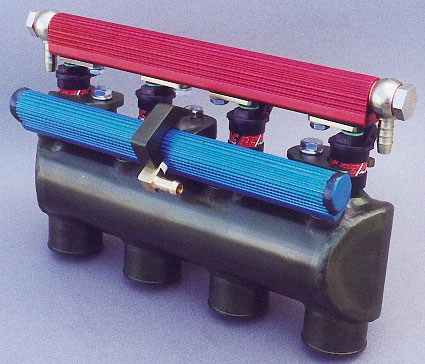

Picture above is our new BMW K1200RS/GT/LT Turbo Plenum with port water injection . Check out our new calculator that we use to design your water injection system.
The newest plenums are heliarced 6061 aluminum with mil-spec hard coat anodizing to resist water/alcohol mixtures. Both the fuel rail (red) and the water injection rail (blue) are anodized for long term protection.
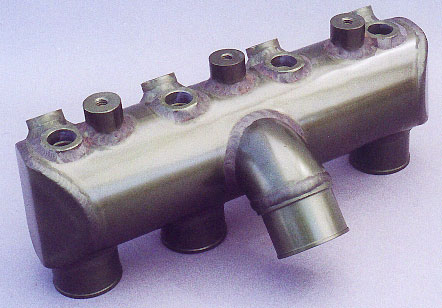
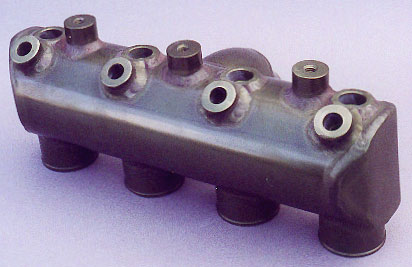
In our testing with the K12 series we have found the higher output engines which put out 100 to 130 crank horsepower need to have water injection for higher boost pressures. Testing with a high load Grinnall car, using water injection (Aquamist), 16 to 18 psi was safely run with high octane gasoline. This is similar to our experiences with the GSXR 1100 Suzukis that we ran at Bonneville and El Mirage in the period 1988 to 1995. All records set by these bikes as well as the K100 Race bikes (312hp 980cc) employed water injection.
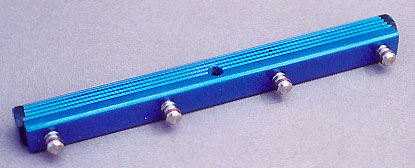
By using four 40cc RSR Water Injection Nozzles we can cover everything from low boost through 300hp. On pump gasoline we like to hold boost between 8 and 12 psi which is 190 to well over 200 hp. For sustained episodes past 12 psi we still recommend running race gasoline in conjunction with the water injection. We have found that no matter what people say, they will end up turning up the boost... so water injection is mandatory.
Jan 2002 to August 2003: Testing has continued with the K1200RS to find the limits of it's power and to try to identify any weak points. The stock compression of 11.5:1 with it's inlet cam closing figures seem to reach their limits at a sustained 10 psi of boost with the oem Mahle pressure cast pistons. Forged pistons and different turbo housings have been designed.
Check out the new RSR Advanced Dynamic Compression Calculator in the tech section on the turbo page. This will show you what you are up against. We did the math for you.
Do this long enough i.e. run in excess of 10 psi and you can crack a piston...we know because we've done it. Running at 5psi the bike is damn fast and you can't hurt it (see the video). Running at 8 psi the bike is over 200 horsepower and it is doubtful that you can hurt it. The bike reaches 80% of it's airflow at 8 psi, that's 80% of 275 to 293hp depending on some environmental factors. Run briefly to 15 psi and short shift it and it will survive...we did it. Turn it loose in the real world and hold it wide open through sixth gear at 10 psi....and sooner or later, maybe 2500 miles later, you can crack a piston...we know, because we did it.
Fuel mapping has been improved with the RSR AIC400. Customers have been able to improve the fuel curves and allowed us to combine the four fuel maps into a more fully developed strategy. The four maps have been edited to prevent any "lean scenarios" but still allow for altitude corrections for higher boost levels. Different fuel maps have been developed for the different forged pistons.
The test bike has been absolutely civil and no changes have been deemed necessary.
New K1200 LT and RS Forged Pistons in Stock
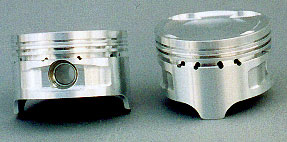
Two different forged pistons that will drop in the stock bores are now available, one for the RS and one for the LT. Owing to differences in oem static compression and cam timing we made these a point lower in compression (on the LT and RS) to allow running up to 12 psi on 91/92 octane gasoline. The pistons are sold in matched sets and come complete with new pins and ring sets. These new K1200RS and K1200LT forged pistons are 7% lighter than their stock counterparts. Being forged, they are inherently stronger and will not crack as will the pressure cast oem pistons. We still recommend using race gas for sustained boost pressures beyond 12 psi.
New 2mm Piston Ring Pins in from Germany
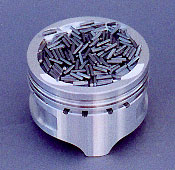
RB Racing gets the honor of pinning the second ring on these forged K1200 turbo pistons. We had special pins flown in from Germany to keep your second ring in the "up" position, just like the oem parts. To be absolutely certain we cut open a factory piston to make sure we got the correct pin. We have enough of these to last a long, long, time.
EFI Upgrades for the K1200RS
Based on our experience with the RS and the LT models we will be soon offering efi upgrades for the stock K1200RS series. Testing is nearing completion on integrated K1200RS upgrade packages with fuel system changes and introducing our RB Racing Black Hole exhaust systems. Major power increases for the power limited RS for those not wanting to go turbo.
"125Hp" Non-Turbo Conversion Kits for the K1200LT in Development

Forged pistons, upgraged ecu calibrations, 350 hp clutch, new RB Racing Black Hole exhaust systems, and larger injectors make up a Kit to give your LT 25 more horsepower. No changes in mileage, just more power. 100 hp just doesn't do the job these days. Still way short of turbo power but a needed shot in the arm for a bike that is, to be kind, a bit weak in the power department. A complete system approach to more useable power. Stay tuned for the video of a K1200LT in action.
Turbo Clutches

The stock clutch in the K1200 series, especially the LT, is a bit weak. When we first turbocharged the K1200LT the first thing we noticed was clutch slippage if shifts were not deliberate i.e. if the clutch was not fully engaged when power was reapplied. K1200LT owners have called asking for these clutches for their stock bikes. They will be available soon. Pictures and technical specification will be posted on these new items. No particular break-in is required and they won't slip even under turbo power.
Compression Ratio Calculations
These new pistons have a piston top volume of 7.6 cc's. On the K1200LT the oem pistons are slightly dished with a piston top volume of 3 cc's whereas the K1200RS pistons are flat topped with only "eyebrow" valve reliefs and a piston top volume of .9 cc's. With a bore on both machines of 2.775", a stroke of 2.952", head gaskets .070" thick, deck heights of .01", combustion chamber volumes of 19.4 cc's, and a rod length of 5.118" you can calculate both the original oem as well as the new compression ratios. Use our RSR Static Compression Calculator and our BMW Advanced Dynamic Compression Calculator to see the results. We aren't going to give you the answers as they are only a few clicks away. Get the new static figures first, then plug the data into the Dynamic calculator.
You need to keep all of this in proper perspective and not get carried away by the allure of more boost. Almost anything you are going to encounter will not outrun you at 8 psi and at 12 psi, with the forged pistons, you will only see small dots in your rear view mirror. For the art of the posible, 22 to 24 psi represents upwards of 350hp. 15 psi is 255 rear wheel hp. Remember that altitude is a major factor in boost pressure calculations i.e. the higher the altitude, the more boost you need to run. You can see the effects of this in our BMW Dynamic Compression Calculator referenced above.
Yeah...But
My bike is fast enough! No it isn't..they never are and BMW's are so conservative that Japan Inc. always has something that will clean your clock. BMW doesn't change things for a decade or more while the Japanese pop out new models on what seems to be now a semi-annual basis...and they get better and better.
Turbos break parts! No, the turbo just sits there passing some oil through it's veins, waiting for you to ask it to pump more air into your motor than it could do by its lonesome. Turbos increase torque, so you shift earlier without having to wind the motor so hard. You don't have to run more than 5 psi to have a 25% increase in power and even at a lowly 8 psi there can be a 50% increase. In short, you can turn up the power for a 100% increase but there is no need to. It's nice to know the potential is there.
I'll wait till BMW Supercharges the bikes. Go ahead and wait. The clock is ticking and even if the bell rings the turbos will be superior. In case you weren't around back in the Formula One Turbo era, turbos were the weapon of choice, even for BMW. Superchargers are there full time, directly coupled to your engine's rpm whether you want the extra oomph or not...and with their fixed drive ratios, your boost is limited. With turbos you recapture wasted exhaust energy and you only use it when you need it...and unlike superchargers, you get to set whatever boost or power level you want.
I'll stick with a pipe and chip upgrade. Boy are you in for a $1000.00 surprise. You are $1,000.00 poorer, the cops can now hear you, and that Motronic computer is busily rewriting all those "not-so-clever" edits back to stoiciometry. Then there's the matter of your exhaust supplier telling you that noise equals power while he doesn't realize BMW fuel limited your equation from the get-go. Then your "chip-guy" didn't understand that BMW programs way below stoichiometry and lets the computer add fuel which takes into account hot weather and high altitude scenarios. Your chip guy tests where his ass is and not where you might go...think about it. BMW routinely looks at these "chips" and has a big laugh. Your bore and stroke are set in stone and your compression ratio is already pretty high...there isn't much you can do.
Turbos cost too much. Your BMW costs too much. In 1971 a R75/5 could be purchased in Germany for $1,300.00 US. Now you pay $15,000.00 to $20,000.00 for your BMW. Turbos are more bang for your buck than anything you can buy, and their level of sophistication and refinement make them a real bargain. These days you often spend money without results. Turbos give results.
I want to win dyno contests...I want to go 200 mph. All of this has been done dozens of times. It all depends on how much horsepower is required for the given situation. Generally if you want to push towards the upper limits, forged, lower compression pistons, water / alcohol injection, and clutch upgrades are necessary. The turbos we use are capable of 28 psi at sea level but run out of air at about 22 psi as beyond this the turbine excedes 180,000 rpm and ceases to "pump" more air. In effect, the compressor wheel appears as a "solid" to the incoming air. In fact, the turbos, at sea level, pump about all the air they were designed for at 15 psi. Running at 2500 feet altitude we never used more that 18 psi and at Bonneville with an altitude of 4500 feet, never more that 20 psi. In dyno contests at sea level, with water alcohol injection we ran up to 22 psi. You can run over 200 mph with as little as 8 psi with one of our larger (K11 / K12/ K100 Race) turbos, assuming you change your final drive ratios. It is a good idea to stick to the factory mandated rev limits in most cases as this keeps the valves from "floating" and keeps the crankshaft in it's design limits. Revving early K100 two valve motors to 12,000 rpm plus would float the valves and break camshafts if stiffer valve springs were not used. BMWs are tough motors, but planning is required for championship bouts.
K1200RS High Altitude Testing
July 2003: Forged pistons in the K1200RS have been tested at 7500 feet altitude and 10 psi. We will be raising the boost to 15 psi at this altitude, then changing the turbo housings to make more measurements. Not everyone runs at sea level and bikes tend to go from Death Valley to 14,000 feet sooner or later and we want all the data to best advise you on the proper setup. So far we have evaluated the stock pistons and compression ratio and are completing our testing of the forged pistons. Some customers want 275 hp and some will be perfectly happy with 180hp...this has to be proven through testing. We don't expect that customers want to have a secondary MOS of "guinea pig".
Smaller turbo housings have been tested to 8500 feet and bring in the boost 1500 rpm earlier during gentle roll-ons. Two versions of the forged turbo pistons have been designed, one for the LT and one for the RS. Using a two point lower compression ratio made the RS a bit sluggish above 8500 feet so the decsion was made to up the compression ratio on that model as it has different cam timing than the LT. Combined with the smaller turbine housing the RS will be extremely responsive even at higher altitudes.
We are running both stock pistons in the K1200RS as well as "stock compression" forged pistons. In higher load applications such as Grinnall cars we have used the 9.5:1 lower compression pistons with higher boost settings.
K1200RS Installation
A lot of customers and dealers have called about "ease of installation"..."hours to install"..."availability" etc. We keep everyone informed about continued testing of things like forged pistons, upgraded components, hot weather, cold weather and high altitude testing and the changes we have made. Some people understand, some don't.
This is serious, hard, and expensive work that has to be done to insure flawless performance. Some people have been extremely incensed that we will not stop our work to schedule an install "next week". At our level it costs far more money to work on bikes than it is worth no matter how insistent the customer is. We are a manufacturer not "bike shop" and, as such, sell the parts to competent individuals and shops that make money working on people's bikes. The only bikes we let in the door are those we use to prototype new parts on and do testing with. It costs us thousands of hours of R&D which in the scope of things is, as they say in business school, "opportunity cost" i.e. it's the lost time that cannot be recovered.
Ideas are expensive and dreams get really expensive. If you sit on the sidelines it all seems so easy. Take a look at the parts, figure out how long it takes to design, test and tool up to make this stuff...then to quantify and document it. It might shed some light on why the government spent $25,000.00 for one extra toilet seat for some aircraft. These aren't parts you can pick up at the hardware store.
Installation is easily accomplished with normal hand tools. Dealers want to know how much they can "make" on the parts and labor and we have a program to accomodate them. Since you have never even seen one of these things much less put on half a dozen of them, plan on spending more time than you thought. If you are adverse to handling wrenches and the smell of engine oil then your dealer or independent shop can handle the details for you. Figure a week of your spare time for a simple install (not installing the forged pistons) or two to three days extra if you want to run higher boost levels and install the forged pistons.
Without the forged pistons we try limit the boost to 8 to 12 psi. This gives you enough horsepower to stay ahead of about anything. We know you won't do this so we are making water injection a mandatory option. With water injection you can briefly run 12 psi on pump gas with the stock pistons and outrun anything you will come up against. For more serious levels of power install the forged pistons, put in higher octane gas and @ 22 psi the engine will be over 300hp. Some of our customers have provided us with a lot of data for extended operation in the 12-15 psi range. If this is your intention then we can advise you on the proper set up. Some of you have expressed interest to go out and avenge certain things to uphold BMW's honor, or whatever...If this is you goal we can offer some advice gleaned over the last 26 years.
Plenums

Fuel system upgrades to the K1200RS Turbo have been tested. K1200RS kits now use 8 new injectors: 4 additional injectors controlled by our RSR AIC400 and 4 injectors to replace the oem injectors. We found we could improve the stock diveability and further refine the mixture of the Motronic N-Alpha and our Speed-Density AIC controller for even more driveabilty. Pictured above is one of the latest generation plenums with Formula 1 style additional injector placement.

New wastegates with investment cast bases have been final machined and kits are being assembled with these new parts. All turbo housings are being machined and welded to accept the new wastegate. After all the machining and welding has been completed the turbo housing gets a polished silver ceramic coating that withstands about anything. AIC programming has been calibrated for both low compression and high compression forged pistons.
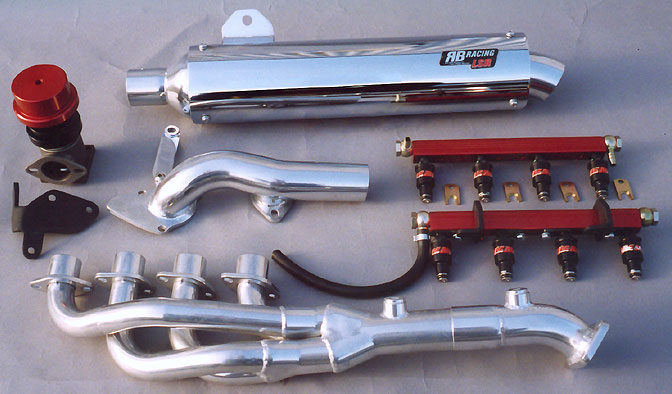
New Black Hole mufflers are being integrated into the turbo kits to provide the ultimate in sound control. New pictures and videos are being prepared to show installation and operation of the turbo system. Above pictured are the latest, as of October 2003, parts for the K1200RS Turbo. The black bracket is a 1/4" thick steel bracket that supports the turbo as does the chrome hanger bracket which is attached to the turbo discharge flange. All K1200RS systems now feature eight new injectors and a new fuel pressure regulator system. New stainless steel investment cast BoostMaster wastegates are shipping. Picture above is the new Black Hole Muffler section that is now used with all RB Racing BMW turbo kits...no restriction and no noise. The Black Hole muffler features a chromed heat shield covering the polished silver ceramic finish. It bolts to the stock oem location.
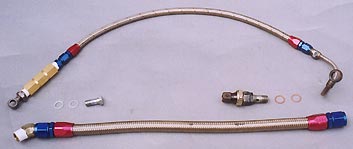
These changes represent small but beneficial improvements over those parts pictured on the earlier 1997 model K1200RS. We have incorporated what we have learned form our Black Hole Muffler testing into the fuel and sound control on all our K1200RS turbo kits. Pictured above are our new oil lines for feed and scavenge. We had to go to a combination hard line and braided stainless on the feed to account for changes BMW has made between the 1997 and 2003 models. We can't tell you how much work all this is.
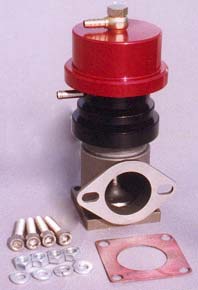
This is our new stainless steel investment cast wastegate that we use with the K1200RS Turbo Kits. We provide stainless steel fasteners and an annealed copper gasket for trouble-free long term performance.

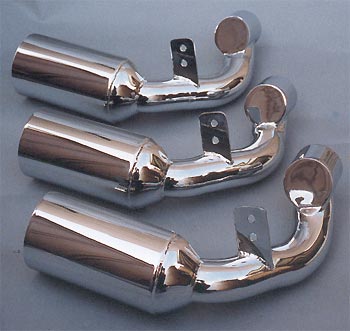
Pictured is the new right side exit filter for the K1200RS Turbo. We moved it from the left side above the muffler to the right side where it is cooler and also a shorter path. New chrome finish. A chrome shield covers the actual filter element.
K1200RS Installation Photos
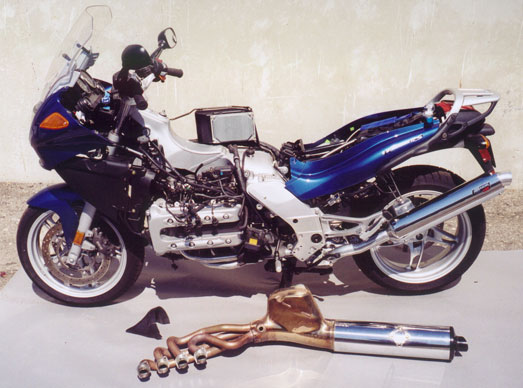
Follow the pictures down the page and see what's involved in the search for horsepower. Whether you do this yourself or pay someone for the job we think you should see the visual details of hat has to be done. Follow us through an installation.
Off comes the body and gas tank with the help of a #25 Torx and a few assorted Allen wrenches. The stock exhaust is removed and the 4-2-1 Turbo header takes it's place. The turbo "pod" with the aircleaner attached (you can't get the aircleaner on after the turbo is in place) is loosely bolted to the 4-2-1 header's 4 bolt turbo flange. The tail section can be bolted to the turbo discharge and the stock wire hanger with it's chrome acorn nut, washer and o-ring are re-used. Put the stock exhaust away.
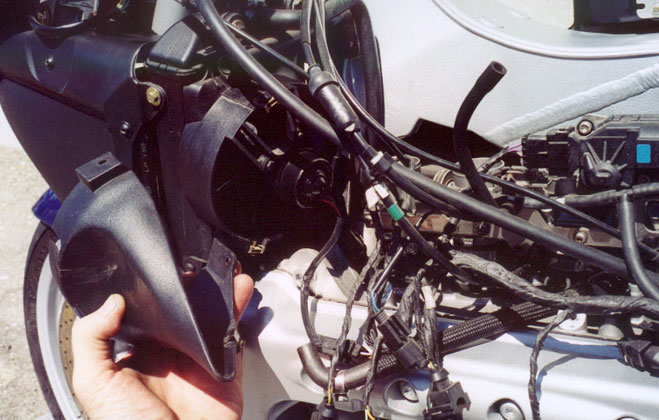
The left fan shroud has to be removed so you can snip a few plastic tie wraps and remove the stock fuel rail and injectors. A couple of screws hold it in place...use a 3mm Allen.
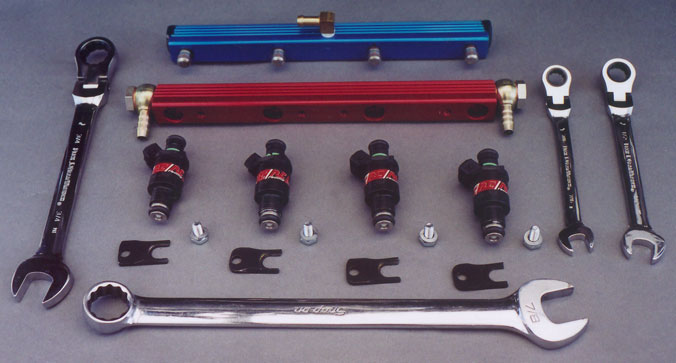
7/8"; 3/4"; 1/2"; 7/16": These are the wrenches you need to deal with the fuel rail nd water injection. The 7/16" wrench tightens the security clips (black) that hold the injectors securely inplace. The 1/2" wrench secures the bolts that hold the water injection rail (1) and fuel rail (2) in place. The 3/4" wrench tightens the banjo bolts on the fuel rail and the 7/8" open end hold the fuel rail when you finally tighten the banjos.
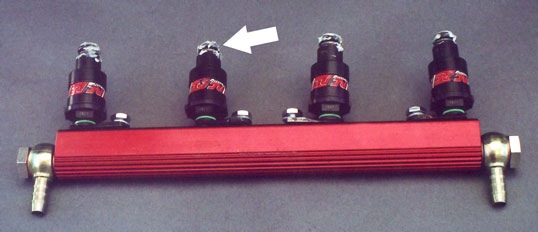
Whenever you deal with injectors and O-rings use a white grease on the injector O-rings. The 4 bolts that hold the injectors to the fuel rail should not be tightened until the final assembly is in place.
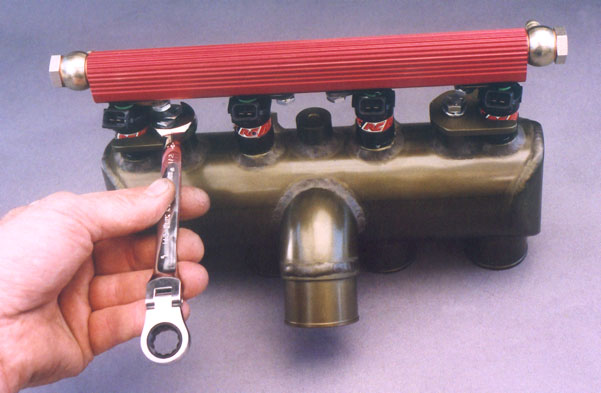
The fuel rail is held by these anodized aluminum security tabs. Use a 1/2" wrench to tighten the bolts. Be sure the injectors are 90 degrees to the rail or you wont be able to reconnect the injector leads. This applies to both primary and seconsary fuel rails.
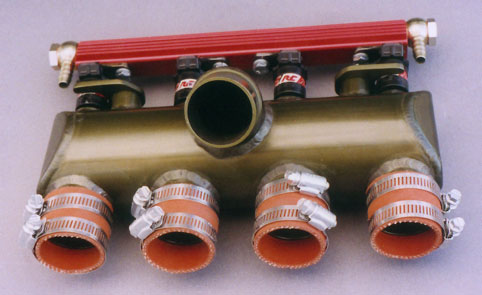
The new inlet couplers are fiberglass reinforced silicone hose that will live forever. We have pictured the hoses on the air chamber to show the postions of the hose clamps. In the instructions we give specific orientations for these so there is no chance for conflicts with throttle mechanisms or other parts. The rubbers are actually placed on the manifold first and then the air chamber is pushed into place. It's easier to show the clamps on the air chamber.
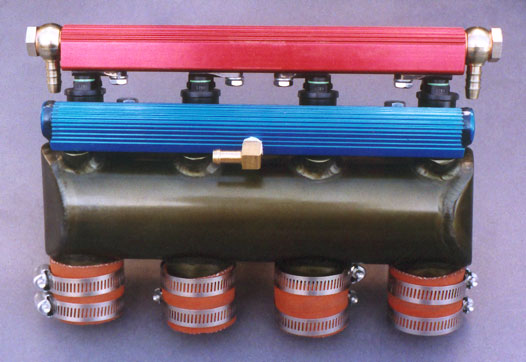
The water injection rail fits into the sockets with the brass inlet facing to the front of the bike. This is the rear view of the air chamber.
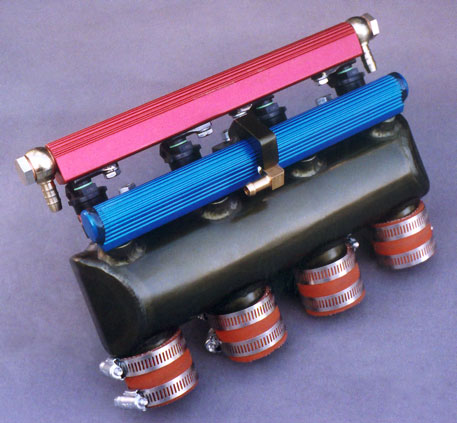
A specially machined clamp holds the water injection rail in place. Use a 1/2" wrench to secure the clamp.
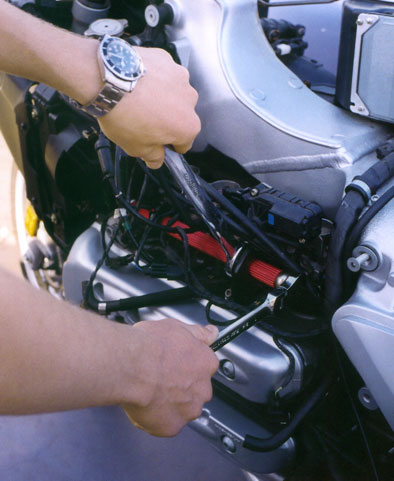
For both the primary and secondary rail you must use a 7/8" wrench to hold the rail while you tighten the banjo bolts into their final position. If you don't you will surely ruin four $80.00 injectors.
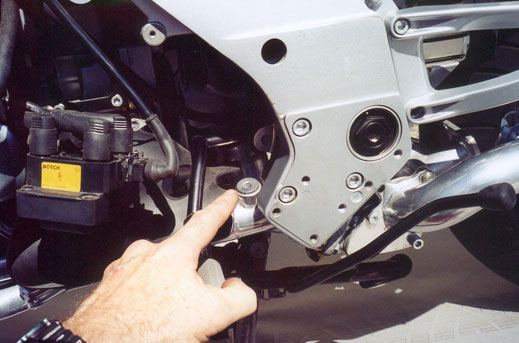
This is the new location for your oem oxygen sensor which we will be modifying for your turbo installation.
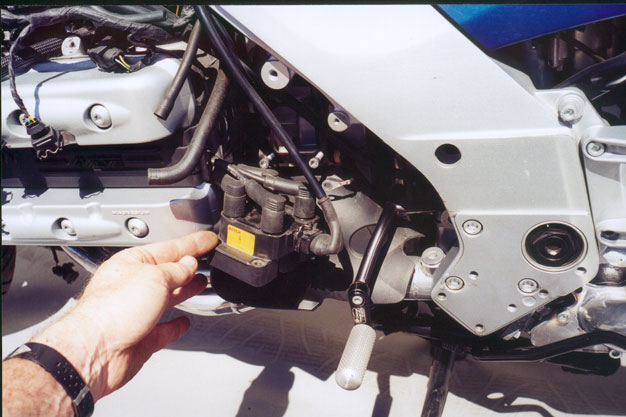
The ignition coil pack is loosened and dropped down. We will be relocating it a bit as it interferes with our turbo plumbing. The stock coil wires are unchanged and we provide a new bracket for the relocation. Note that the foopeg casting has been removed...We have plans for this area that we will show you later.
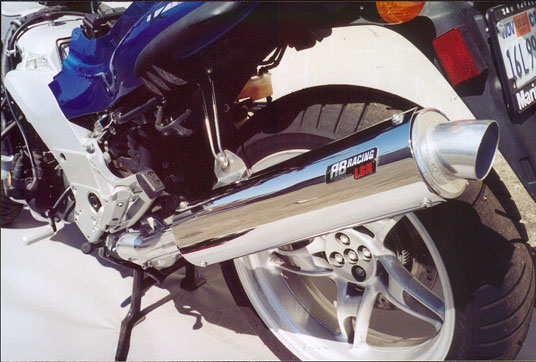
This shows that the stock hanger is used to support the Black Hole Muffler section. On all our K12 Black Hole exhausts we have a new internal core that is quieter and bypasses 40% more air. Progress never stops.
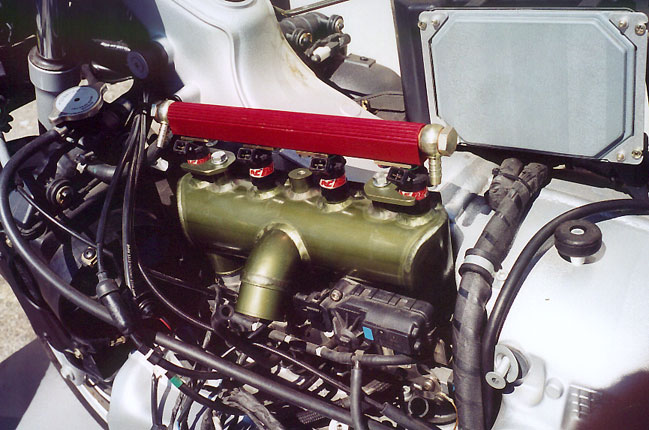
This shows the postion of the new plenum chamber that has the four-port water injection. We'll be showing you how this all hooks up. The box to the right is your Motronic Ecu.
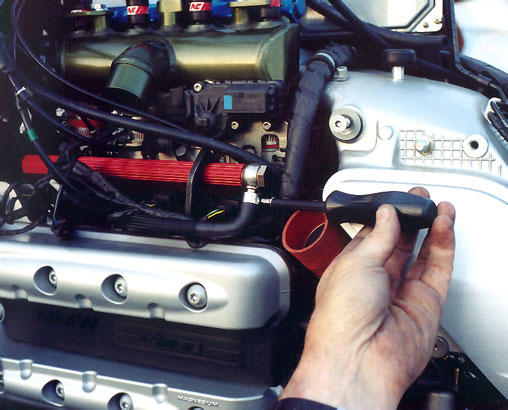
Use a 7mm nut driver to reattach the oem fuel line (feed from the pump) to the rear of the new fuel rail. There is a clip in the mid point of the oem line bolted to the engine case that will restrict it's movement. This clip has to be loosened to re-position the hose. Use a 7/8" wrench to hold the rail itself and a 3/4" wrench to tighten the banjo into this location. Do not forget to tighten the fuel hose clamp with either a 7mm nut driver or a screwdriver.
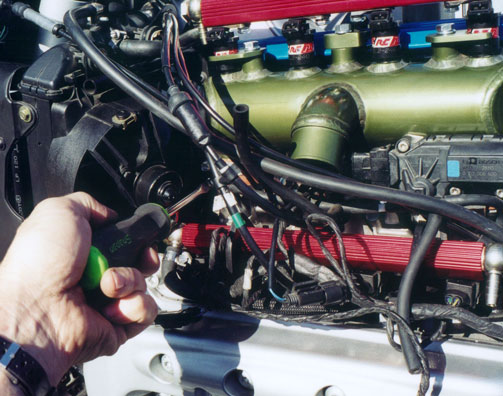
There are eight clamps that secure the plenum to the inlet tract. Pictured in several pictures above they go on in a very specific orientation. If you do not check the throttle movement you are most likely going to tighen the clamps where they conflict with a moving part. If you don't check this at this point you will be removing bodywork and the gas tank later on when the throttle binds. Take note that the throttle cable simply slips into a socket and it is easily knocked out of it's location with all the activity in this area.
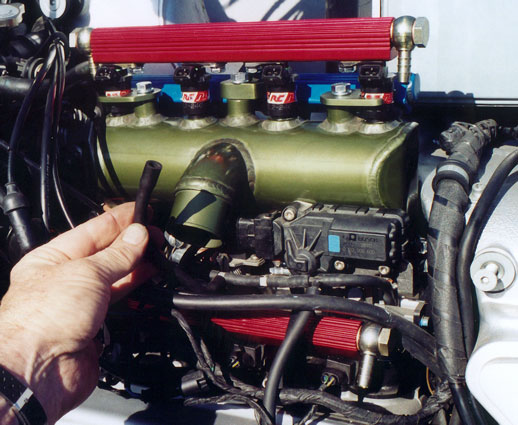
This part of the vacuum line system is no longer used. You are going to have to pull off the vacuum lines as BMW never thought we were going to run positive inlet pressures.
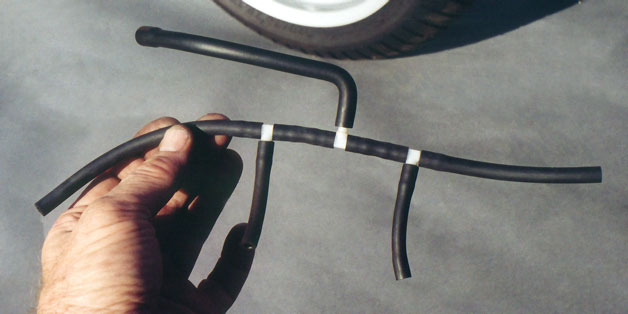
These lines simply push on to the brass tubes in the four throttle bodies. They may or may not slip off easily which means they may or may not blow off easily under positive pressure. We use super glue and then safety wire them back into place,
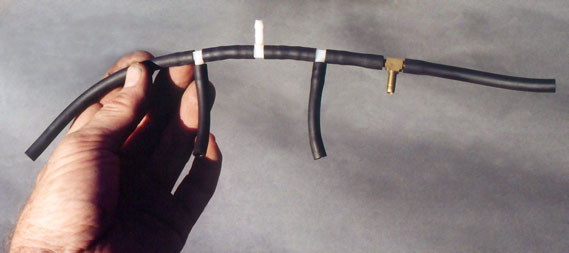
An additional port is added to take care of the new fuel pressure regulator. We use a brass "T" because it is failure proof. The oem BMW "T's" were designed to go the distance but other plastic ones that come from Auto Parts stores you may try to use will not survive.
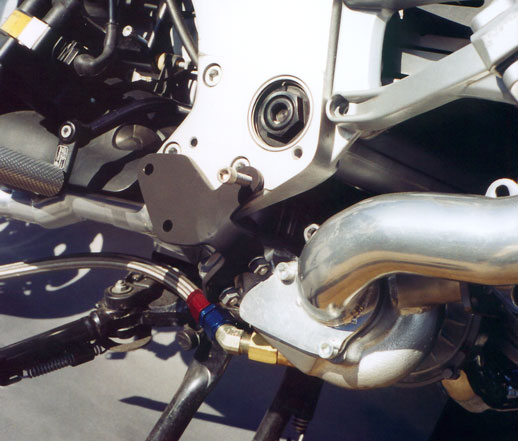
Vibration. Moment of inertia. Mass. The turbo has to be supported by itself independently of the 4-2-1 exhaust manifold. The 4-2-1 turbo exhaust manifold has a slip joint (no clamp) to allow for expansion and to remove stress from the assembly. The turbo is suspended from the frame with a thick steel plate which carries the majority of the load as well as preventing rotation of the assembly. The turbo is additionally suspended from the right side of the bike with the air cleaner bracket.
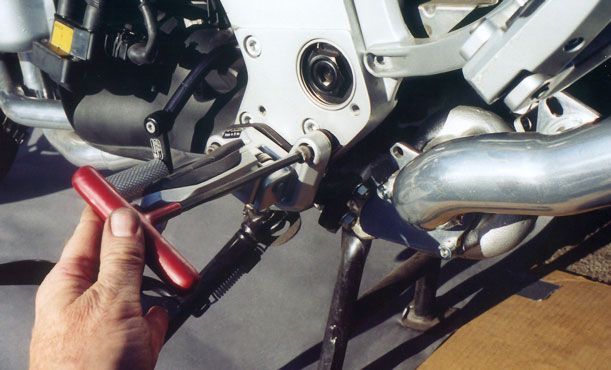
We supply longer stainless steel socket head cap screws to reattach the footpeg assembly. 6mm Allen required.
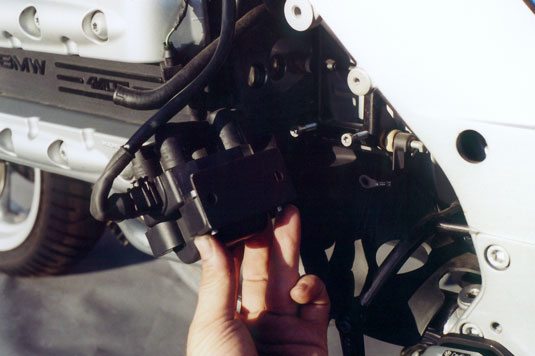
The ignition coil is relocated with a bracket we provide. The plug wires are unchanged. The stock bracket is kept and the new bracket attaches to the old bracket. Relocating the coil allows the turbo connector pipes (2) to snake through this area on their way to the inlet plenum.
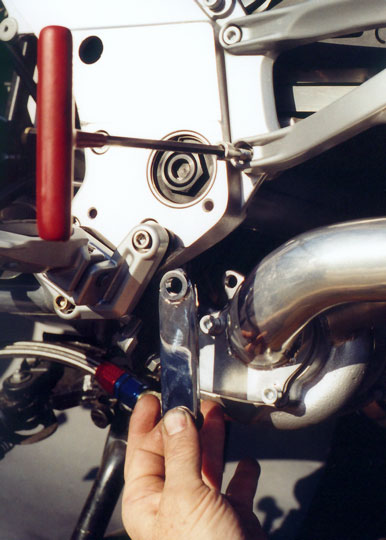
To keep the turbo located in the vertical plane we provide a specially fabricated hanger that is attached to an ear on the turbo exit flange. The bracket is attached behind the frame rail. We provide a longer stainless socket head cap screw that holds the barcket to the frame but still allows it to pivot front to rear. This dampens any vertical loads.
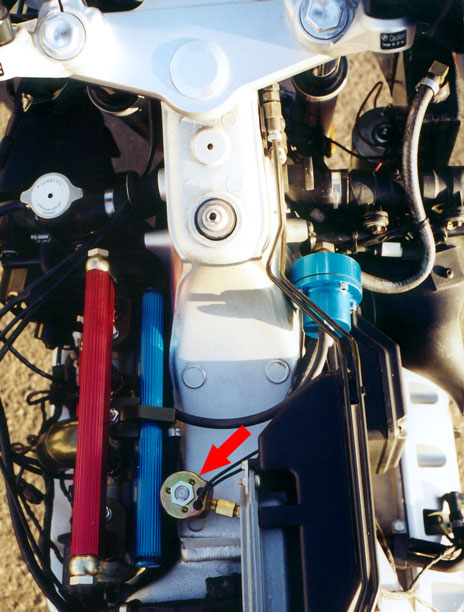
A fast acting 12 VDc bubble-tight solenoid valve is located at the fuel rail to positively stop any water from entering the engine unless the engine is under boost. The water injection pump cannot be activated unless the engine is running and under boost. Water is filtered at each nozzle as well as just before the solenoid so there is no possibility of nozzle clogging.
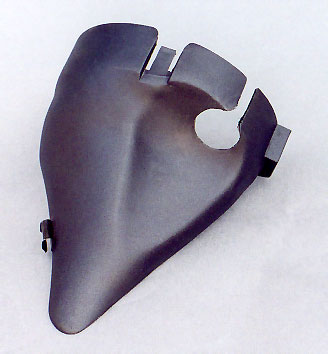
Your left hand radiator fan shroud needs to have a 1" diameter (25mm) hole cut at the end of the slot that is used for the fan wire. Simply place a quarter ($0.25) and scribe around it then clean up to 1" diameter. This is to avoid any pressure on the shroud from the new fuel rail. Use a 3mm Allen wrench to remove the shroud. When it comes time to install the new primary fuel rail and upgraded injectors the shroud and the injectors will have to go in at the same time. You can't bolt either one in first. Once the injector and fuel rail and the shroud are in place you can replace the two allen screws that hold the shroud in place (3mm allen) as well as install the two fuel rail hold downs (5mm allen wrench).
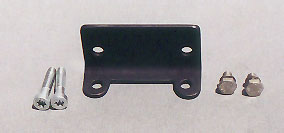
This is your new coil relocation bracket that will also serve as double duty for your new fuel pressure regulator bracket. There are a total of four (4) #30 Torx screws that are going to get replaced. The short 6mm x 1.0 x 10mm hex bolts will hold the new bracket to the old coil bracket. The two "ears" will hold the ignition coil and the new fuel pressure regulator. Longer allen bolts are provided to hold the coil and fuel regulator to these ears.
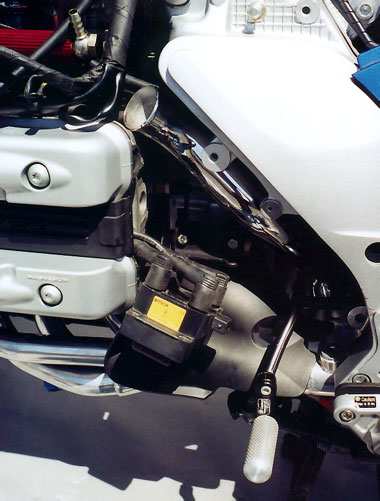
Here the new coil bracket is in place and the connector tube from the turbo compressor has been slipped onto the turbo with a 1 3/4" silicone hose and two hose clamps. If you don't put the connector tube in place before you bolt down the coil you'll never get it snaked into place. It only goes one way so there are no options. You can see the coil relocation bracket held in place by the new 6mm hex bolts.
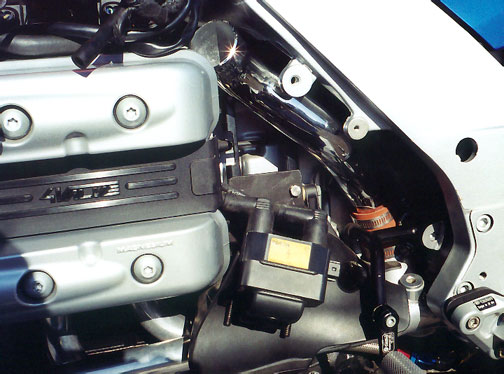
The silicone hose is slipped over the turbo discharge and two hose clamps are slipped into place. You don't tighten these at this point because "a" goes to "b" and "b" goes to "c" etc. If you tighten the crap out of things as you go along then things simply will not align or fit.
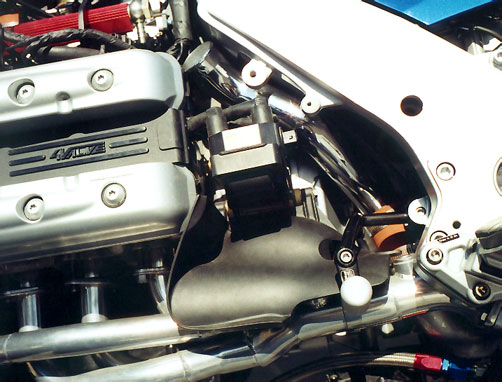
Once you've got the hose in place you can put the coil on its new bracket. Two new allen bolts with nuts and lockwashers are provided. The rearmost allen bolt will also hold on the new fuel pressure regulator.
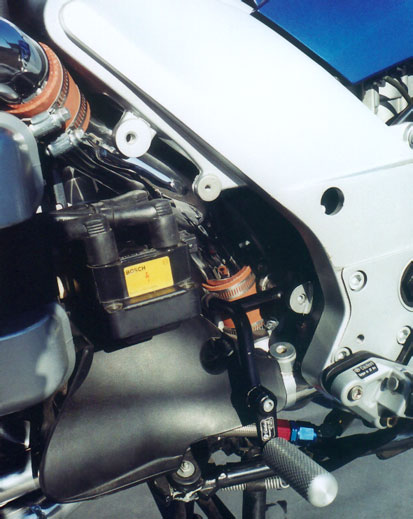
The #2 chromed turbo connector tube is joined to the tube you just attached to the turbo. You can't mix up any of these hoses as they are the same diameter and length. Note the position of the clamps.
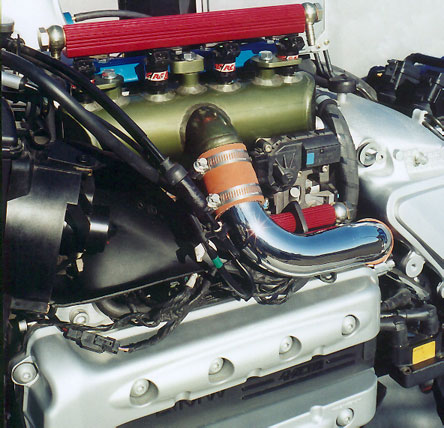
Here's the #2 connector tube connected to the plenum. It only goes on one way. Once again. note the position of the hose clamps. These always have to be kept out of the way of other parts on the bike.

Location of the new fuel regulator. It has a tab and is bolted to the new coil bracket. Fuel passes through both fuel rails and goes to the side of the regulator. The fitting on the bottom of the regulator is where the fuel is by-passed back to the gas tank. The brass nipple on the top of the regulator is referenced to manifold pressure, both vacuum and boost. Fuel pressure is set at RB Racing but is adjustable.
0-30 PSI, Dual EGT, Oil Pressure, H2O Activation
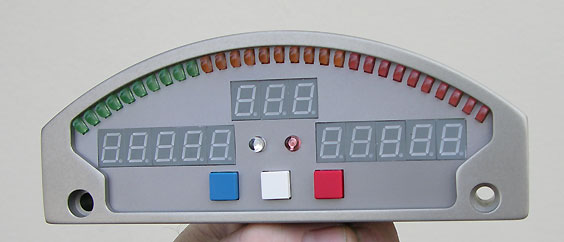
We now use digital dash displays. in all our turbo kits. Memory functions. Deg F and Deg C Type K Thermocouples along with 3 Bar Bost display.
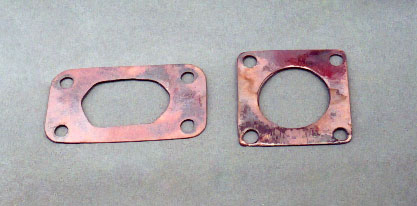
Copper gaskets for the wastegate and turbo. The connection between the turbo and turbo exhaust manifold gets a rectangular 4 bolt annealed copper gasket. The square annealed copper gasket goes from the turbo to the wastegate base. Copper will not leak or blow out and can be reused. We machine these, heat them cherry red and then quench them in water to make them soft. Stainless steel fasteners hold the surfaces tight.
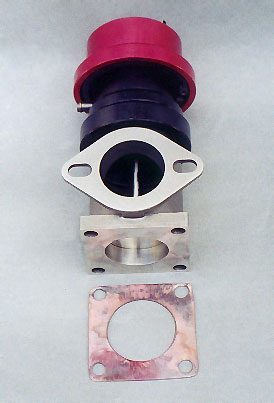
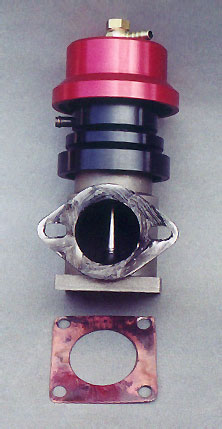
Our BoostMaster wastegates use the annealed copper gasket on the base and a coat of silicone on the two bolt exit flange to the Black Hole muffler section. There is never any need to make another gasket. Metal to metal, or metal to metal to metal. No fiber gaskets to tear, blow out or that have to be remade.

This is the brains of the fuel control system, the RSR AIC400 Additional Injector Controller. We machine the boxes out of billet just like we do for our RSR Air Fuel Ratio Gauges and then hard anodize them. We write four maps for the application that will cover anything you want to do with the bike. The Grey knob is a +/- 10% adjustment feature. We write the maps so nothing can be entered "wrong". The boxes are set up for either 2 or 3 Bar calibrations. The RSR AIC400 controls the four additional injectors located in the top of your plenum chamber. These injectors cover the difference between the Motronic's programming and the turbo or boost horsepower. The four additional injectors point straight down each throttle bore for perfect distribution. There is a red l.e.d. which indicates the unit is working. It only activates above 1200 rpm and ceratin manifold pressures. If you rev the throttle you should see the l.e.d. blink which indicates the additional injectors are firing. We have changed our suggested mounting position for this unit which we previously hid under the seat.
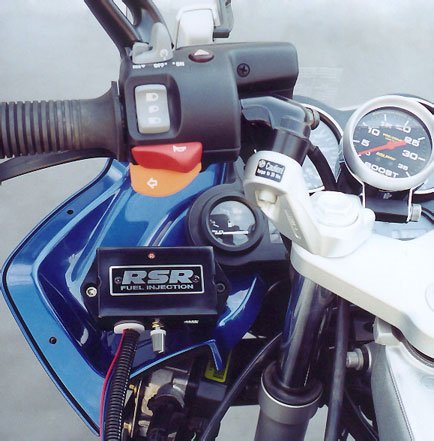
This is the new location for the RSR AIC400 Additional Injector Controller. It is waterproof and in a position for rider adjustment.
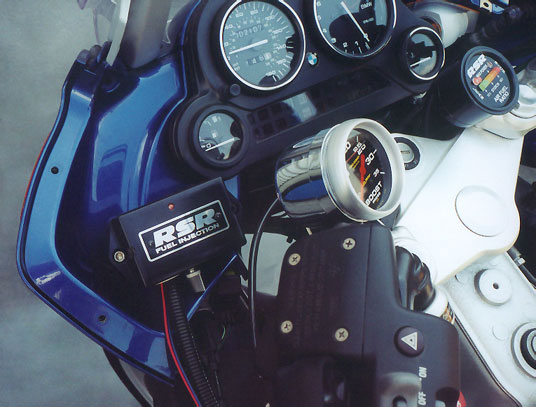
You can select from 4 fuel maps as well as trim the fuel with the grey knob. The RSR AIC400 controls the four additional injectors located in the top of the plenum chamber. There is a red l.e.d. which indicates the injectors are firing. There are over 1200 programmed points with resolutions in the smallest fraction of a millisecond to correctly match the horsepower needs. The four maps with the trim knob will cover any boost or load condition as well as atmospheric/weather condition present. The maps are written so the user cannot choose something "wrong". The unit may be adjusted "on the fly". The hard anodized billet enclosure resists any corrosion.
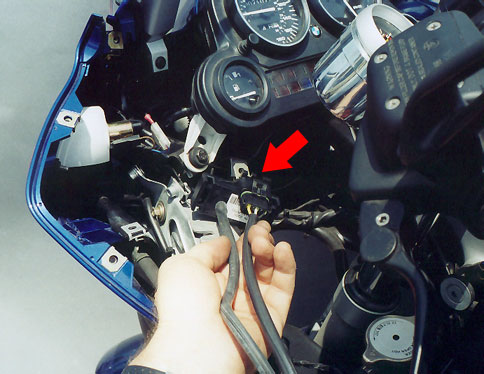
Manifold Pressure Sensor for the RSR AIC400 is located in the nose of the bike beneath the panel holding the RSR AIC400. These sensors are either 2 Bar or 3 Bar. There is a 20" line connected to vacuum/boost.
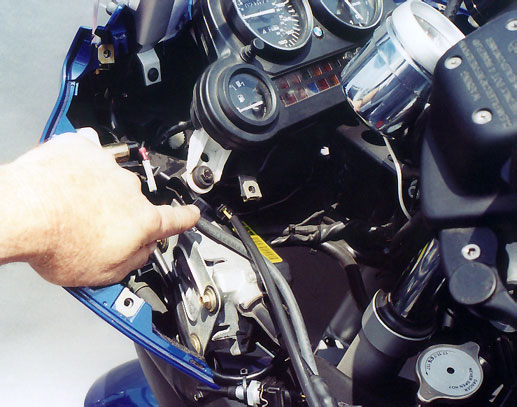
The MAP Sensor is secured to the firing support bracket with a plastic tie wrap. Pneumatic lines must be roted so there is no chance of chaffing or pinching.
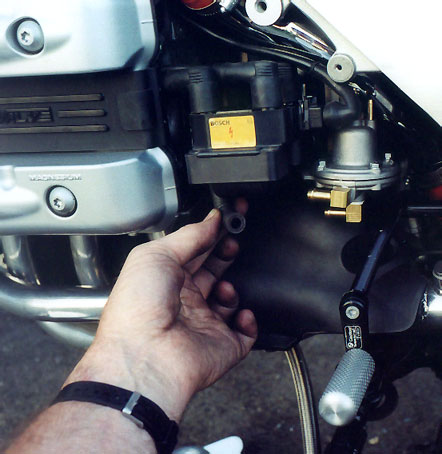
The return or by-pass fuel that goes back to the gas tank gets routed to the bottom of the fuel pressure regulator. The line is not long enough so we provide an extension.
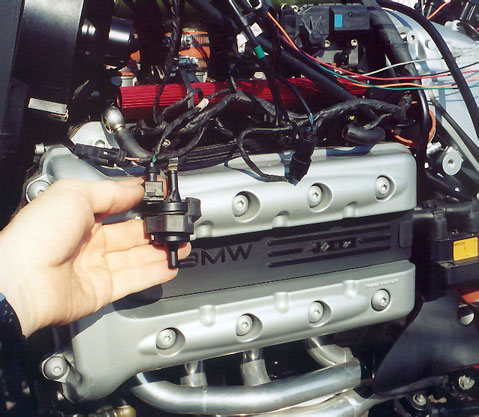
A solenoid valve that is no longer part of the system once you go turbo. Two wire connector (Green/White Stripe; Green/Blue Stripe). You can tuck it out of the way or remove it. The Motronic will be telling it to do something but it won't have anything to do.
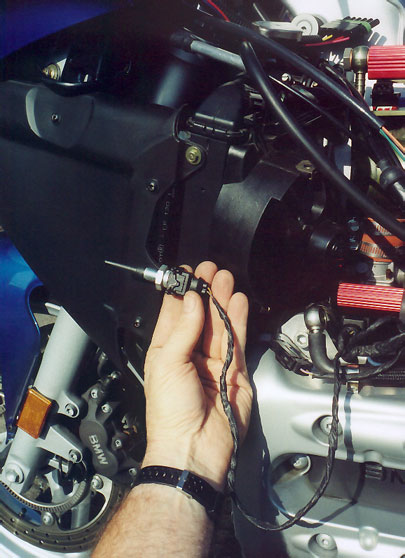
This is your air temperature sensor that you will remove from your plastic inlet chamber. It has a two wire connector (Brown/Yellow Stripe; Brown/Blue Stripe). The lead wire is long and you will use two plastic tie wraps to secure it to a fairing support tube behind the large black plastic shroud ahead of the radiator. In this position it will sense ambient air but will not see the compressed inlet air from the turbo.

Use a plastic tie wrap to secure the air temperature sensor here, above the plastic radiator shroud away from the radiator heat but with exposure to the air coming up under the fairing nose.

The 4-2-1 Ceramic Coated header is a two piece affair: the header itself and the slip joint with the four bolt turbo flange. You have to install these two parts at the same time or you won't be able to put the slip portion on.
The eight nuts that hold the header to the motor should only be lightly tightened. These will not be tightened until the turbo, the air cleaner and bracket and the footpeg support bracket are in place.
The upper inside bolt is a button head as a hex head will "hit" the turbo discharge tube. The other three bolts are hex heads with the outside two being longer as they have to capture both the turbo and the support bracket that mounts from the footpeg area. All four bolts face to the "rear". The annealed four bolt copper gasket (see below)is installed with a light coating of either the Permatex 598 or the Hylomar.
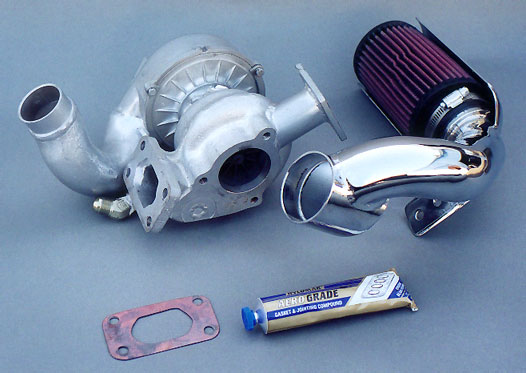
The turbocharger is shipped "loose" so the center housing and left and right sides of the turbo can be rotated into place. It takes 8mm and 10mm wrenches to tighten the center section into it's final position. Note than there is no bolt on the top of the compressor housing...we cut it off.
The turbo must be lifted into place with the air cleaner assembly slipped onto the inlet of the turbo. Use the 598 Permatex Ultra Black or the Hylomar to seal the machined slip fit. The chrome hanger bracket suspended from the right side passenger peg will align with the two holes in the chrome inlet tube.
A light coating of Permatex or Hylomar is placed on the four bolt annealed copper gasket. The correct position for the compressor side (snakey looking part) is rotated completely up against the head of the button head screw.
The correct position of the center section is that the feed and drain are completely straight up and down. Use 8mm and 10mm wrenches to tighten the center section into its final location. You will install the oil feed line after the turbo is tightened in place.
The air cleaner inlet bolts to the outside of the hanger bracket with two bolts.
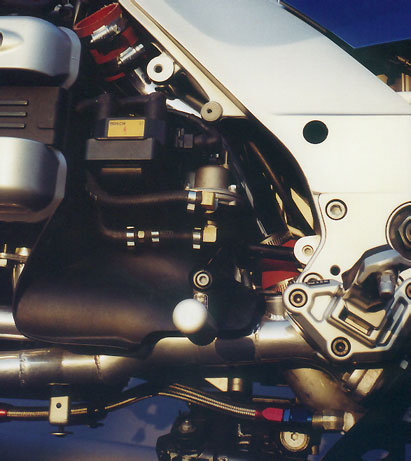
The fuel bypass or return line to the tank has been extended with a short piece of fuel injection line and two extra clamps. The feed line which comes from the rear of the upper or secondary injector rail is routed to the side of the regulator. The nipple on the top of the regulator will be attached to the vacuum/boost lines that are connected to the area beneath the four butteflies in the throttle bodies.
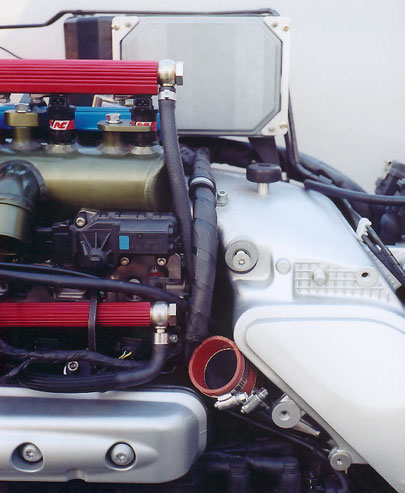
Here we can see the oem fuel feed from the pump going to the rear of the primary fuel rail. The original clamp is used.
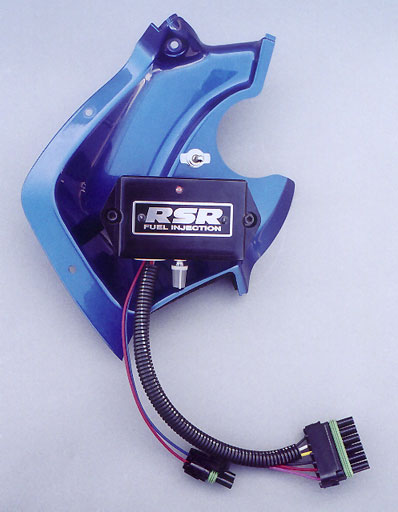
The operation of the +/- 10% grey trim knob and the selection of four additional injection maps is easily accomplished. The red l.e.d. indicates the injectors are firing.
The chrome two position switch above the RSR AIC400 arms the water injection system. The water injection cannot be activated unless the bike is actually running and the turbo boost has reached a preset level.
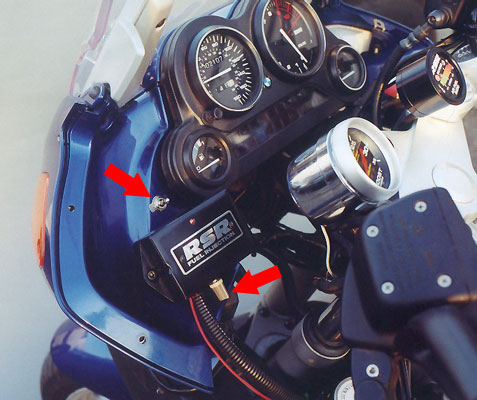
The RSR AIC400 is mounted in place using a 4mm x 55mm allen bolt on the right and a 1/4 x 20 x 2 1/2" allen bolt on the left.

We supply machined black Delrin dowels which support the billet enclosure. As the left panel surface is curved, the procedure is to mount the RSR AIC400 on it's right delrin dowel to the oem 4mm clip and then place the left dowel beneath the AIC billet enclosure and scribe a drill location.
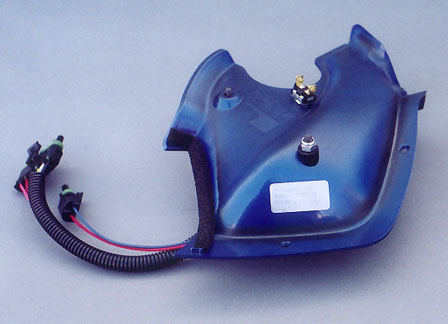
A short mirror image delrin bushing is provided for the rear of the panel so the 1/4 x 20 nylock (esna) nut has a square surface to tighten to. Only lightly tighten this to avoid distorting the panel.
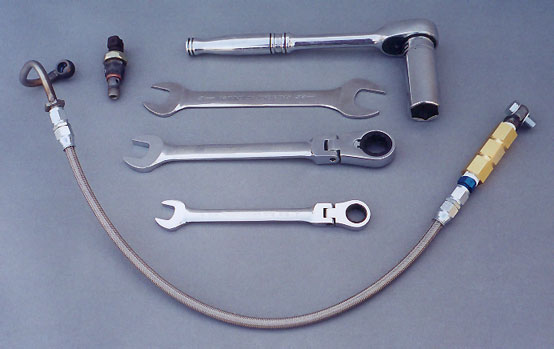
AN4 oil feed line and necessary tools. It takes a 24mm deep socket to remove the oem oil pressure switch from the lower left side of the engine. It takes also a 3/4", a 9/16", and a 24mm wrench to tighen things. We machine a special banjo bolt that accepts the oem oil pressure switch as well as feeding oil to the turbocharger. We ship these assembled but we ask that you be absolutely sure no dirt or debris has gotten into the line before you install it. These banjo bolts can be overtightened and damaged so don't use a lot of leverage on them. Teflon tape is only used on pipe threads, not straight threads.
Late K1200 models have a quick release injector style connector on the oil switch. Early models do not have this connector.
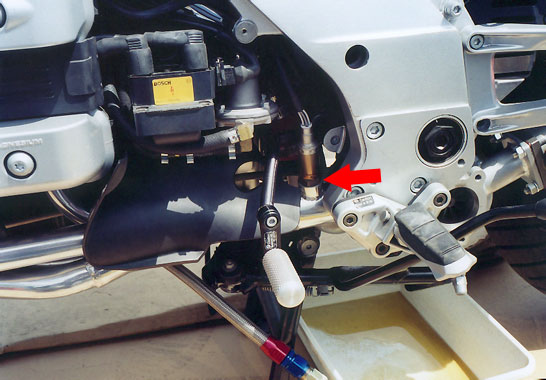
New oxygen sensor location. Use 7/8" open end wrench to tighten the O-sensor into place. If you have not disconnected the sensor from its plug upstream simply twist it ccw the number of turns ( 3.5 to 4) it takes to tighten it so the wires will not be twisted when they are tightened.
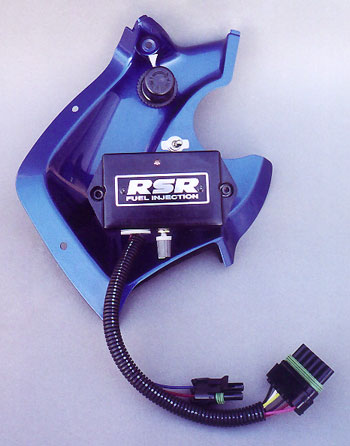
Pneumatic boost controller installed. Fully counterclockwise is "off" meaning it is just on the spring pressure in the wastegate (5 psi). As you turn the knob clockwise the boost increases. Eleven turns is fully locked out which means between 24 and 28 psi at sea level. Lift the knob to adjust and push it down to lock it at whatever boost level you choose. Normally we set things at 8 psi and turn it up to 12 psi if things need to get serious.
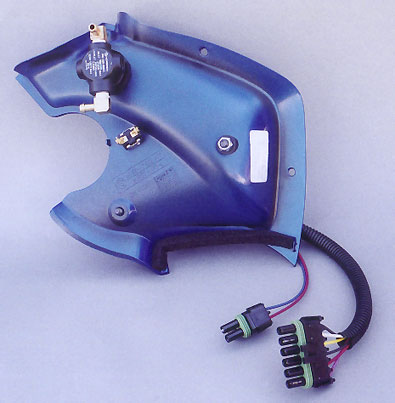
A hole 1.125" in diameter must be made in the plastic. The hole must be "high enough" or the back of the pneumatic boost controller will run right into the back of the light bulb in the fairing. If you put the hole in the wrong place it's too late.
The brass hose fittings should be installed in this orientation. You need to be sure that the the two lines that push on to these fittings are not kinked in any manner. The pneumatic controller has an arrow indicating the direction of flow. The "out" is a long line that leads back to the top of the wastegate. The two side ports are plugged with teflon tape on the 1/8"NPT allen plugs (3/16" allen wrench).
The RSR AIC400 is set to work with either a 2 bar (15 psi) or a 3 bar (30psi) map sensor at the time you order. Those wishing to run in excess of 255hp (15psi) must order the 3 Bar configuration as well as the forged pistons. Water injection is mandatory for all systems.
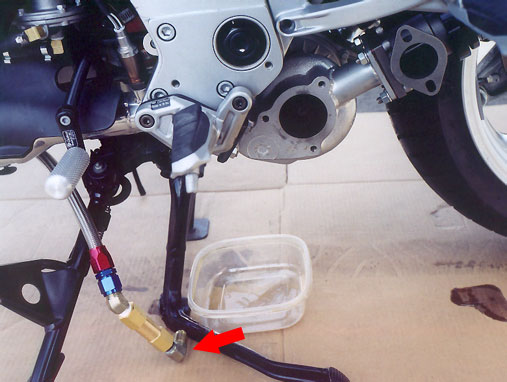
Ready for testing the oil system. This assumes you have checked all fuel line fittings for leaks and that the fuel rails are tightened into place. Vacuum lines must not be "open" to the atmosphere. The red arrow points to a "plugged" fitting on the AN8 oil scavenge line.
If you start the bike with this line "open" it will suck air into your main system instantly. We block off the fitting so that when we start the bike you can check for oil leaks on the pan, lines and fittings as well as verify oil flow through the turbo. You should verify oil level in the sight window on the other side of the bike as, once the bike starts, things like the oil filter and the various lines and passages will fill up. You will have to immediately check this to bring the oil to the proper level in the sight window. We have made a video of the oil scavenge testing (see below).
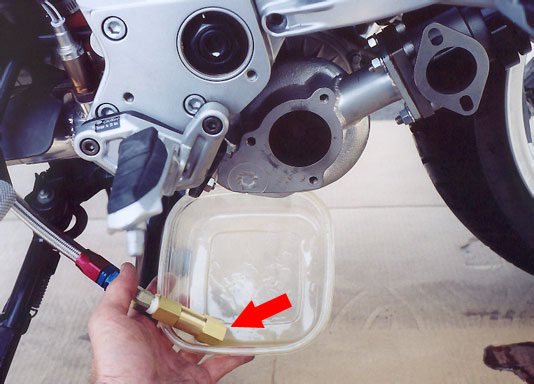
Once oil leaks are checked and oil flow from the turbo is verified you will: a. Fill a shallow container with oil; b. Remove the oil blocking plug from the scavenge line; c. Place the end of the scavenge line in the oil; d. Start the engine and verify scavenging as the oil also drains into the pan from the bottom of the turbo (see movie below).
Do not allow the engine to run if the line can "suck" air. Have someone ready to shut the bike off when the oil level drops too low in the pan. Two people required.
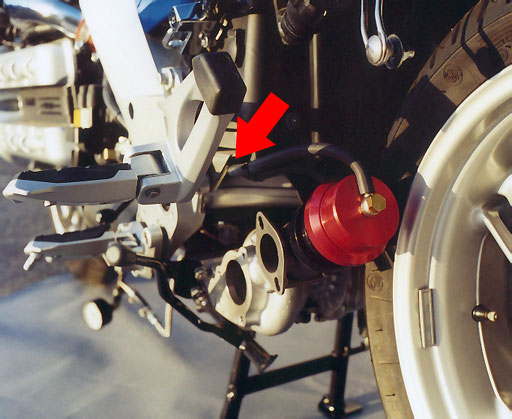
Pneumatic lines (2) to the wastegate are 7/32" vacuum lines. The "boost pressure only" is routed to the side of the wastegate. The line to the top of the wastegate is connected to the exit of the pneumatic dial-a-boost controller. The two hoses are held together at various points along their journey with small plastic tie wraps. Their first entry into the underworld is beneath the stainless steel sheet metal battery /abs box, and then over the top of the swingarm casting, past the Popes upside down in the burning mud.

Exiting Hades the two lines pass the gasoline-filled river Styx and skirt the holy coil mount and tuck under the chromed boost aqueduct. Routed atop the fuel feed line they continue on their journey to salvation, tucked behind the fan shroud and up past the radiator cap...to meet their all powerful Dial-A-Boost deity.
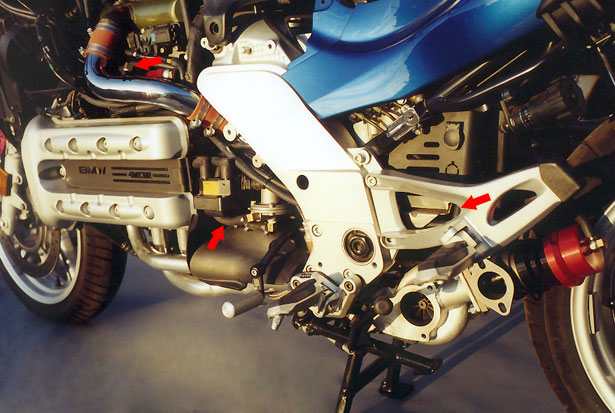
The upper arrow points to where the boost only circuit picks up its signal, from the chromed connector tube. The lower arrow points to where the fuel line is connected from the rear of the upper, or secondary injector, fuel rail. Note it is slightly canted down to arc beneath the ignition coil mount. The right arrow points to where the boost only line which goes to the side of the wastegate has a brass "t" which snakes up inside the black plastic cover (external charging socket) and goes to the second Hobbs switch that we have wired into our electronic control of the oem O2 circuit.

Arrows right to left. The first arrow points to where the the vacuum/boost signal is taken from the throttle bodies and leads to the fuel pressure regulator hat. Fuel pressure is pre-set at RB Racing for you, but is user adjustable. Fuel pressure tracks boost pressure on a 1:1 basis. The oem pressure regulator does not track manifold pressure. The second arrow points to the source of the "boost only" circuit. The third arrow points to a brass "t" which leads to the Hobbs Switch that turns on the water injection. This switch resides atop the fan shroud. The fourth arrow points to the location of the Hobbs switch that activates the water injection.
The K1200 series are a packaging challenge as they are so integrated that there is simply no room for anything. We have located the turbo in a tight 3 dimensional space that has fractions of an inch clearance in all directions. It just so happens that this is beneath the engine oil level, which means the turbocharger cannot possibly "drain". For over 20 years all of our turbochagers have been positively scavenged i.e. we "suck" the oil out of the turbocharger faster than it "goes into the turbo".
The K1200RS and LT series pose a severe challenge in this regard when you factor in the difficulties of the turbo placement and the variables like ambient temperature and engine oil temperature. We have 20 years of engineering experience in this area and it is something that has consumed several thousand man hours over the various applications not counting the production time of the application specific components. Watch the movie to see what has to be tested in your installation phase.

Water injection tank in final fitment with fittings teflon taped and hose clamps crimped on the feed, pressure and return lines.
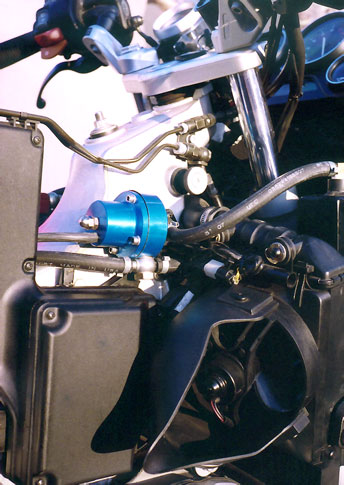
Return or bypass water goes out the base of the regulator and returns to the hard anodized tank.
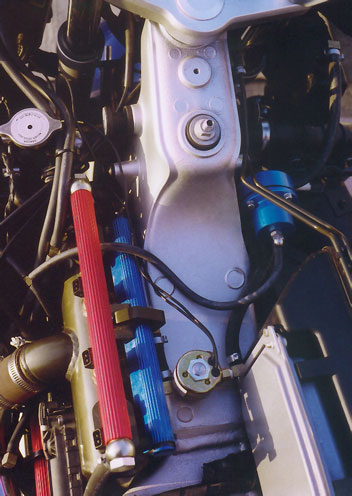
Water pressure regulator is referenced to the boost circuit. It tracks boost pressure 1:1 and is set at 40 psi by RB racing. The pressure can be changed with an adjustment screw in the hat of the regulator.
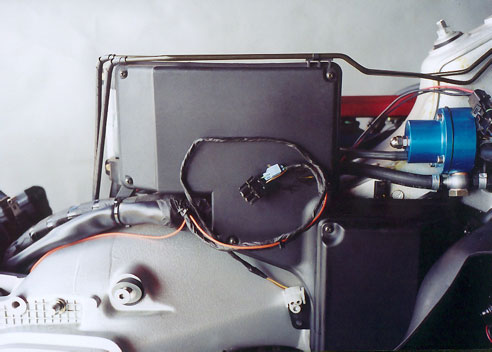
The fuel pump connector is where we pick up one of the 12VDc signals for the water injection harness.

This is the water injection relay. It is also wired to your alternator (we supply a special plug) so that the water injection can activate only if the engine is actually running at at 6 psi or above.
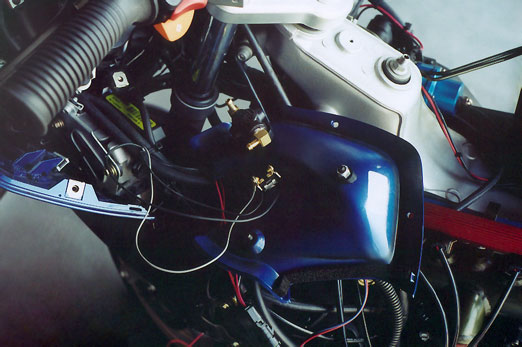
Here we wire in the ON-OFF switch for the water injection. This either arms or disarms both the water pump and the bubble-tight solenoid. If you are running low boost you can turn it off...or if you run low on water you can switch it off. The logic is controlled by the water injection solenoid.
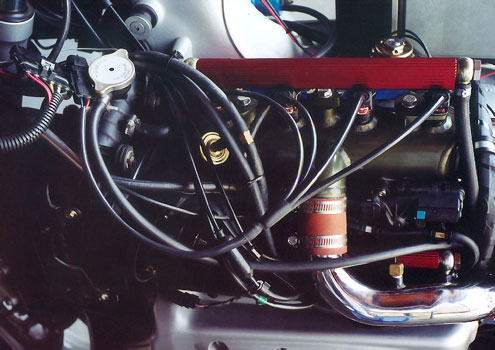
This is the wiring harness for the four secondary injectors controlled by our RSR AIC400.
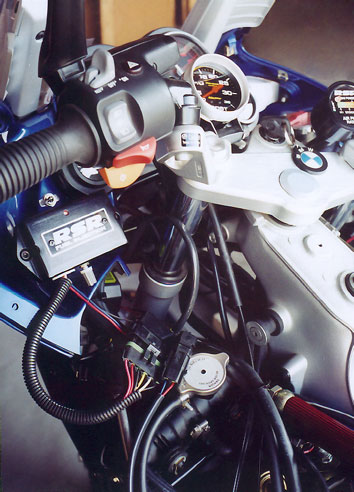
The RSR AIC400 has a six pin and a two pin silicon sealed connector. The two pin is for the injector harness.
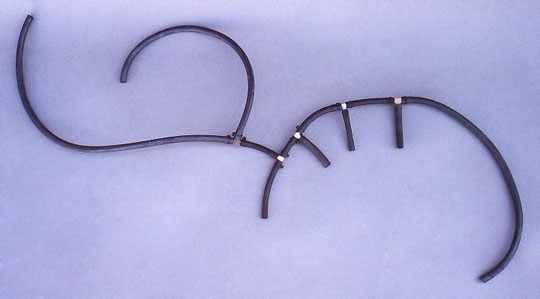
This is your vacuum / boost circuit. It connects the four throttle bodies to your fuel pressure regulator, your 2 or 3 bar map sensor and your water pressure regulator.
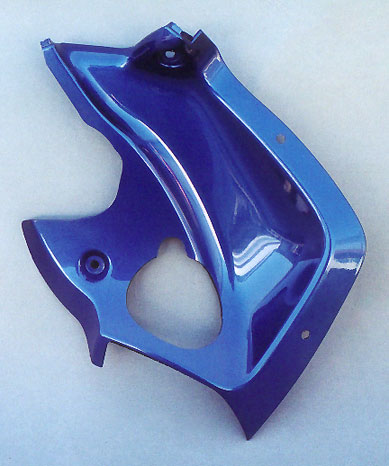
Hole to allow filler neck for hard anodized water injection tank. Use 2" hole saw cutting from the back of the part and then use a die grinder to shape the final fit.
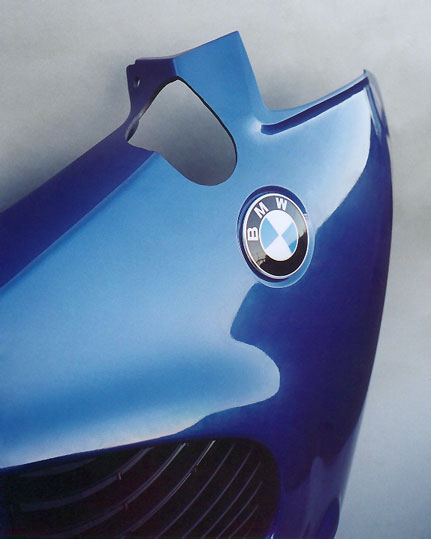
Right side fairing. Using the right front inner panel as a guide you can trace the shape you need to cut tis opening. You will have to install both parts on the bike to trace this hole. We suggest you use a magic marker to draw a line on the parting line of this part and the fairing nose piece. If you do not do this, you are liable to cut the hole too far down and it will be visible from the outside.

This shows the location of the hole. Do not attempt to free form or guess this cutting operation. Use the inner dash panel and trace the cutting area onto this part. We mark the approximate center of this area and use a 2 1/2" hole saw, cutting from the back side and then use a die grinder to finish the job. Since you are marking or scribing the part on the painted side, drill pilot holes (2) on the center of the circular portions and then use the 2 1/2" holesaw to cut the holes (2) coming from the back or unpainted side. Do not attempt to cut from the painted side was the saw may "wander".
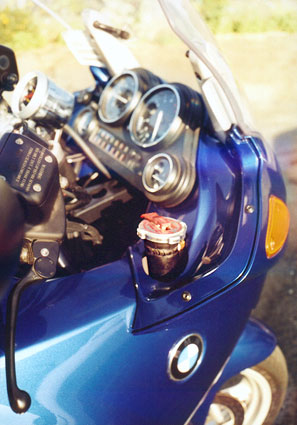
This is the filler neck after the fairing has been modified. You should check the fluid level if you have armed the system and have been activating the water under boost.
Black Hole technology means quiet speed. Listen to a 275hp K1200RS Turbo idle. Watch it cruise and also hit 8psi of boost with the individual port water injection activated. You can buy all the little widgets you want but there is only one really serious way to level the playing field and you are looking at it.
The price for the turbo kit is $7,995.00 for a 2 Bar (15 psi) application. For a 3 Bar system (30 psi) the price is $8,995.00 which includes forged pistons and a higher output turbo. Some of you have called and asked if we do the installations...the answer is no. The reason for this is that between production of parts, handling day to day communications, and the usual interruptions we do not have the time to do installs. No particular mechanical skills are required, just careful thoughtful assembly and fitting.
Reality Check
This may be your hobby but it is our business and in a business sense, turbos make little sense. That we choose to do them is our choice and it has nothing to do with money. The R&D and the tooling and the testing is money that you never get back...Never! Never! Never! No one appreciates what you do and almost no one understands what is involved. We have done enough free work and R&D to pay for a mansion in Beverly Hills. It is our choice. Got to love turbos if you want to play with them.
We get calls from people who want to know if the exhaust they have will work with the turbo (think about it). We have people who call and tell us they will be happy with 200hp all the time (?). We have people call and tell us they are coming by for an installation...they don't ask, they just announce it. We tell them no and they tell us we are assholes. Got to love turbos if you want to play with them.
We have worked with a number of customers on prototypes. Several have announced they were not going to pay us any money because "RB Racing" was going to get rich off the prototype. We offered any of these people to simply pay us for our time and parts and we'll let them have the business. For some reason they always decline the offer. Something about them getting their regular paycheck without any risk or investment. Got to love turbos if you want to play with them.
Over 600 BMW turbos and 1500 turbos for more than 25 platforms over the years. Thousands and thousands of man hours and hundreds of thousands of dollars invested. Computer code, flow benches, test equipment, custom software, electronic circuitry design, specialized castings, cnc and manual machinery, fixtures, specialized fabrication and welding equiment, training of employees etc etc. Got to love turbos if you want to play with them.
Be prepared. This is serious stuff. Know your responsibility. These aren't phony carbon fiber tank protectors.